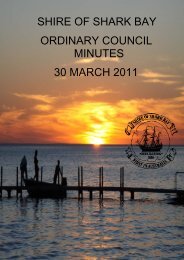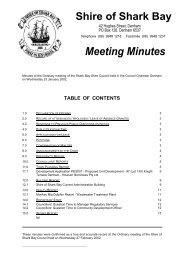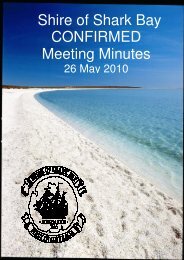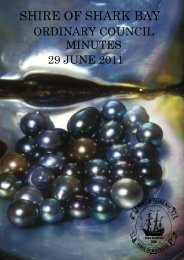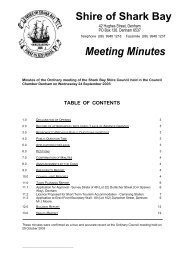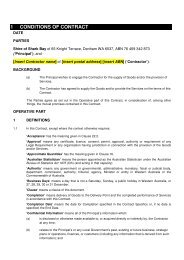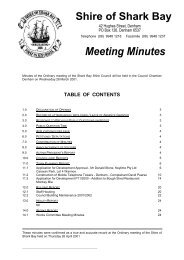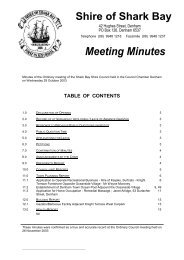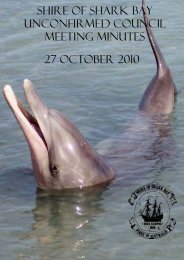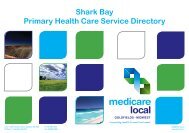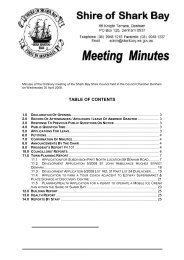Ordinary 070530Minut.. - Shire of Shark Bay
Ordinary 070530Minut.. - Shire of Shark Bay
Ordinary 070530Minut.. - Shire of Shark Bay
Create successful ePaper yourself
Turn your PDF publications into a flip-book with our unique Google optimized e-Paper software.
ORDINARY COUNCIL AGENDA - 30 MAY 2007 Page 14<br />
opportunities and incentives for development to incorporate different products,<br />
systems, and construction methods.<br />
2 A rationale for the application <strong>of</strong> tourist zonings in a Town Planning Scheme, including<br />
an assessment <strong>of</strong> land supply, types <strong>of</strong> accommodation and scale/character <strong>of</strong><br />
development.<br />
This component should combine the research and analysis information to arrive at<br />
conclusions about what types <strong>of</strong> tourism developments are needed, how much land,<br />
in what location, in what strategic status. For example, an identified need for a larger<br />
or additional caravan park in the next three years, or a 100 bed hotel in five years.<br />
An assessment should be undertaken <strong>of</strong> the types <strong>of</strong> tourist zones currently used and<br />
obvious physical patterns <strong>of</strong> tourism development, any historical trends impacting<br />
development, and the availability <strong>of</strong> land for future tourism development.<br />
Future tourist zonings should reflect the scale/character <strong>of</strong> preferred development.<br />
This includes the potential for the creation <strong>of</strong> specific tourist zones that reflect<br />
particular types <strong>of</strong> accommodation - the tiered zoning framework (eg 'hotel', cabin/<br />
chalet zones).<br />
The Strategy should also address the need for strategic tourism locations and special<br />
control areas. The Ministerial Taskforce Report provides an example <strong>of</strong> potential<br />
zones and how they are defined, and appropriate classifications for land uses within a<br />
model zoning table.<br />
3 Identification <strong>of</strong> strategic and non-strategic tourism sites/locations or activity locations<br />
and the specific processes, provisions and assessment criteria to guide the planning<br />
and development <strong>of</strong> these areas. Sites identified as 'Strategic' will be 100 percent<br />
short stay. 'Non-strategic' sites may have a maximum <strong>of</strong> 25 percent permanent<br />
residential. These categories should be differentiated via the zoning table in the Town<br />
Planning Scheme.<br />
Criteria for strategic site identification (as per the Ministerial Taskforce Report) are as<br />
follows -<br />
a) Sustainability - the site should provide for tourism development that is<br />
sustainable in respect <strong>of</strong> its construction, operation and function.<br />
b) Planning context - the site has been identified in a regional planning strategy or<br />
in a region plan as having high tourism potential and value.<br />
c) Accessibility - the ease <strong>of</strong> access to the site or the associated attraction<br />
generally should be high, and appropriate to the nature <strong>of</strong> the facility or<br />
attraction.<br />
d) Uniqueness - the site may contain or be in the vicinity <strong>of</strong> an attraction <strong>of</strong><br />
landmark value, or itself be <strong>of</strong> landmark value.<br />
e) Setting - the site may have an aspect and outlook that facilitates recreational<br />
tourism activities and/or the creation <strong>of</strong> a tourism character and ambience.<br />
f) Tourism activities and amenities - the site provides, or has easy access to,<br />
supporting activities and amenities such as tours, fishing, historic sites, walk<br />
trails, cafes, etc.<br />
g) Alternative sites - the site has an element <strong>of</strong> scarcity in that it may be the only<br />
opportunity to achieve a significant tourism development in an area.<br />
h) Suitability - the site is located within a land use context that will not overly limit<br />
the extent <strong>of</strong> activities <strong>of</strong> guests within the resort due to amenity impacts on<br />
adjoining residents or where the adjoining uses potentially will detract from the<br />
tourism character <strong>of</strong> the site.<br />
i) Capability - the site has the capacity to be developed for tourism purposes and<br />
accommodate the associated services in a manner that does not detract from<br />
the natural attributes <strong>of</strong> the site.



